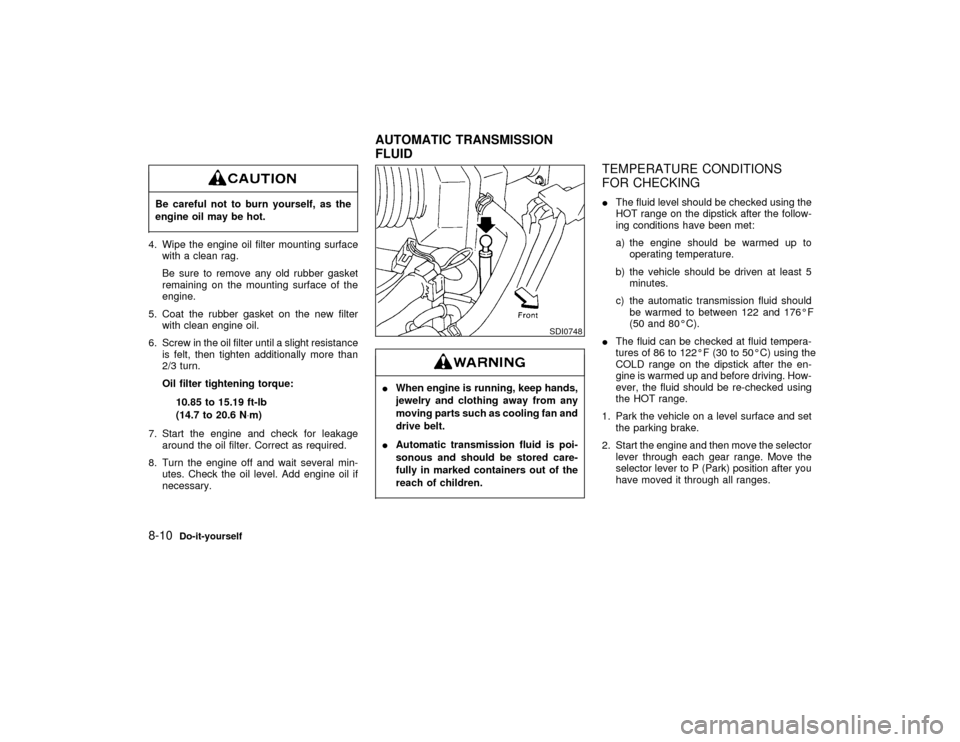check transmission fluid NISSAN MAXIMA 1999 A32 / 4.G Owners Manual
[x] Cancel search | Manufacturer: NISSAN, Model Year: 1999, Model line: MAXIMA, Model: NISSAN MAXIMA 1999 A32 / 4.GPages: 233, PDF Size: 1.96 MB
Page 52 of 233

and the foot brake systems.
Parking brake indicator:
When the ignition key is in the ON position, the
light comes on when the parking brake is
applied.
Low brake fluid warning light:
The light warns of a low brake fluid level. If the
light comes on while the engine is running with
the parking brake not applied, stop the vehicle
and perform the following:
1. Check the brake fluid level. Add brake fluid
as necessary. See ªBrake and clutch fluidº
in the ªDo-it-yourselfº section.IYour brake system may not be work-
ing properly if the warning light is on.
Driving could be dangerous. If you
judge it to be safe, drive carefully to
the nearest service station for re-
pairs. Otherwise, have your vehicle
towed.
IPressing the brake pedal with the
engine stopped and/or low brake fluid
level may increase your stopping dis-
tance and braking will require greaterpedal effort as well as greater pedal
travel.
IIf the brake fluid level is below the
MIN mark on the brake fluid reservoir,
do not drive until the brake system
has been checked at a NISSAN
dealer.
2. If the brake fluid level is correct, have the
warning system checked by a NISSAN
dealer.
or
Anti-lock brake
warning light (if so
equipped)
After turning the ignition key to the ON posi-
tion, the light will illuminate. The light will turn
off after about 2 seconds if the system is
operational.
If the light comes on while the engine is
running, it may indicate there is something
wrong with the anti-lock portion of the brake
system. Have the system checked by your
NISSAN dealer. However if the light illumi-
nates while starting the engine, it does not
indicate a system malfunction.
If an abnormality occurs in the system, the
anti-lock function will cease but the ordinarybrakes will continue to operate normally.
If the light comes on while you are driving,
contact your NISSAN dealer for repair.
Low fuel warning light
This light comes on when the fuel in the tank is
getting low. Refuel as soon as it is convenient,
preferably before the fuel gauge reaches E.
There will be a small reserve of fuel remain-
ing in the tank when the fuel gauge needle
reaches E.INDICATOR LIGHTS
Overdrive off indicator light
This light comes on during driving when the
overdrive switch is pressed to prevent over-
drive operation.
The O/D OFF indicator light comes on for 2
seconds each time the ignition key is turned
ON. This shows the light is functioning prop-
erly.If the O/D OFF indicator light blinks for
approximately 8 seconds after coming on for
2 seconds, have your NISSAN dealer check
the transmission and repair it if necessary.The automatic transmission is equipped with
an electronic fail-safe mode. This system al-
Instruments and controls
2-9
Z
01.1.22/A32-D/V5.0
X
Page 160 of 233

8 Do-it-yourselfMaintenance precautions .......................................... 8-2
Engine compartment check locations ....................... 8-4
Engine cooling system .............................................. 8-5
Checking engine coolant level .................................. 8-5
Changing engine coolant .......................................... 8-6
Engine oil .................................................................. 8-7
Checking engine oil level .......................................... 8-7
Changing engine oil .................................................. 8-8
Changing engine oil filter .......................................... 8-9
Automatic transmission fluid ................................... 8-10
Temperature conditions for checking ...................... 8-10
Power steering fluid ................................................ 8-11
Brake and clutch fluid ............................................. 8-12
Window washer fluid ............................................... 8-12
Battery ..................................................................... 8-13
Drive belts ............................................................... 8-15
Spark plugs ............................................................. 8-15
Replacing spark plugs ............................................. 8-16
Air cleaner ............................................................... 8-17Windshield wiper blades ......................................... 8-18
Cleaning .................................................................. 8-18
Replacement ........................................................... 8-19
Parking brake and brake pedal ............................... 8-20
Checking parking brake .......................................... 8-20
Checking brake pedal ............................................. 8-20
Brake booster .......................................................... 8-21
Clutch pedal ............................................................ 8-21
Fuses....................................................................... 8-21
Engine compartment ............................................... 8-22
Passenger compartment ......................................... 8-23
Lights ....................................................................... 8-24
Headlights ............................................................... 8-25
Exterior and interior lights ....................................... 8-26
Tires and wheels ..................................................... 8-31
Tire pressure ........................................................... 8-31
Types of tires .......................................................... 8-32
Tire chains............................................................... 8-33
Changing tires and wheels...................................... 8-33
Z
01.1.22/A32-D/V5.0
X
Page 169 of 233

Be careful not to burn yourself, as the
engine oil may be hot.4. Wipe the engine oil filter mounting surface
with a clean rag.
Be sure to remove any old rubber gasket
remaining on the mounting surface of the
engine.
5. Coat the rubber gasket on the new filter
with clean engine oil.
6. Screw in the oil filter until a slight resistance
is felt, then tighten additionally more than
2/3 turn.
Oil filter tightening torque:
10.85 to 15.19 ft-lb
(14.7 to 20.6 N×m)
7. Start the engine and check for leakage
around the oil filter. Correct as required.
8. Turn the engine off and wait several min-
utes. Check the oil level. Add engine oil if
necessary.
IWhen engine is running, keep hands,
jewelry and clothing away from any
moving parts such as cooling fan and
drive belt.
IAutomatic transmission fluid is poi-
sonous and should be stored care-
fully in marked containers out of the
reach of children.
TEMPERATURE CONDITIONS
FOR CHECKINGIThe fluid level should be checked using the
HOT range on the dipstick after the follow-
ing conditions have been met:
a) the engine should be warmed up to
operating temperature.
b) the vehicle should be driven at least 5
minutes.
c) the automatic transmission fluid should
be warmed to between 122 and 176ÉF
(50 and 80ÉC).
IThe fluid can be checked at fluid tempera-
tures of 86 to 122ÉF (30 to 50ÉC) using the
COLD range on the dipstick after the en-
gine is warmed up and before driving. How-
ever, the fluid should be re-checked using
the HOT range.
1. Park the vehicle on a level surface and set
the parking brake.
2. Start the engine and then move the selector
lever through each gear range. Move the
selector lever to P (Park) position after you
have moved it through all ranges.
SDI0748
AUTOMATIC TRANSMISSION
FLUID
8-10
Do-it-yourself
Z
01.1.22/A32-D/V5.0
X
Page 170 of 233

3. Check the fluid level with the engine idling.
4. Remove the dipstick and wipe it clean with
lint-free paper.
5. Reinsert the dipstick into the charging pipe
as far as it will go.
6. Remove the dipstick and note the reading.
If the level is at the low side of either range,
add fluid to the charging pipe.
IDo not overfill.
IUse only NISSAN Matic D (Continen-
tal US and Alaska) or genuine auto-
matic transmission fluid (Canada).
Dexron
TMIII/Mercon
TM
or equivalent
may also be used. Outside the conti-
nental US and Alaska contact a
NISSAN dealer for more information
regarding suitable fluids, including
recommended brand(s) of Dexron
TM
III/Mercon
TM
automatic transmission
fluid.
NOTE:
If the vehicle has been driven for a long
time at high speeds, or in city traffic in hot
weather, or if it is being used to pull a
trailer, the accurate fluid level cannot be
read. You should wait until the fluid has
cooled down (about 30 minutes).Check the fluid level in the reservoir tank.
The fluid level should be checked using the
HOT range at fluid temperatures of 122 to
176ÉF (50 to 80ÉC) or using the COLD range at
fluid temperatures of 32 to 86ÉF (0 to 30ÉC).
IDo not overfill.
IUse type DEXRON
TMIII or equivalent.
SDI0496
SDI0118
POWER STEERING FLUID
Do-it-yourself
8-11
Z
01.1.22/A32-D/V5.0
X
Page 199 of 233

and that the locks (if equipped) hold securely
in all latched positions.
Seat belts:Check that all parts of the seat belt
system (for example, buckles, anchors, adjust-
ers and retractors) operate properly and
smoothly, and are installed securely. Check
the belt webbing for cuts, fraying, wear or
damage.
Accelerator pedal:Check the pedal for
smooth operation and make sure the pedal
does not catch or require uneven effort. Keep
the floor mats away from the pedal.
Clutch pedal*:Make sure the pedal operates
smoothly and check that it has the proper free
play.
Brakes:Check that the brakes do not pull the
vehicle to one side when applied.
Brake pedal and booster*:Check the pedal
for smooth operation and make sure it has the
proper distance under it when depressed fully.
Check the brake booster function. Be sure to
keep floor mats away from the pedal.
Parking brake*:Check that the lever has the
proper travel and make sure that the vehicle is
held securely on a fairly steep hill when onlythe parking brake is applied.
Automatic transmission P (Park) position
mechanism:Check that the brake pedal must
be depressed for the selector lever to be
moved from the P (Park) position. On a fairly
steep hill check that the vehicle is held se-
curely with the selector lever in the P (Park)
position without applying any brakes.
Under the hood and the vehicleThe maintenance items listed here should be
checked periodically (for example, each time
you check the engine oil or refuel).
Windshield washer fluid*:Check that there
is adequate fluid in the tank.
Engine coolant level*:Check the coolant
level when the engine is cold.
Radiator and hoses:Check the front of the
radiator and clean off any dirt, insects, leaves,
etc., that may have accumulated. Make sure
the hoses have no cracks, deformation, dete-
rioration or loose connections.
Brake and clutch fluid levels*:Make sure
that the brake and clutch fluid levels are be-
tween the MAX and MIN lines on the reservoir.
Battery*:Check the fluid level in each cell. Itshould be between the MAX and MIN lines.
Engine drive belts*:Make sure that no belt is
frayed, worn, cracked or oily.
Engine oil level*:Check the level on the
dipstick after parking the vehicle on a level
spot and turning off the engine. Be sure to wait
a few minutes to allow the oil to drain back into
the sump.
Power steering fluid level* and lines:Check
the level in the reservoir tank with the engine
off. Check the lines for proper attachment,
leaks, cracks, etc.
Automatic transmission fluid level*:Check
the level on the dipstick after putting the selec-
tor lever in P (Park) position with the engine
idling.
Exhaust system:Make sure there are no
loose supports, cracks or holes. If the sound of
the exhaust seems unusual or there is a smell
of exhaust fumes, immediately locate the
trouble and correct it. (See ªPrecautions when
starting and drivingº in the ª5. Starting and
drivingº section for exhaust gas (carbon mon-
oxide).)
Underbody:The underbody is frequently ex-
9-4
Maintenance
Z
01.1.22/A32-D/V5.0
X
Page 205 of 233

EXPLANATION OF MAINTENANCE
ITEMSAdditional information on the following
items with ª*º is found in the ª8. Do-it-
yourselfº section.Emission control system
maintenanceDrive belts*:Check drive belts for wear, fray-
ing or cracking and also for proper tension.
Replace the drive belts if found damaged.
Air cleaner filter:Under normal driving con-
ditions, the air cleaner filter should be replaced
in accordance with the maintenance schedule.
However, driving the vehicle in dusty areas
may cause more rapid clogging of the element.
Consequently, the element may have to be
replaced more frequently.
EVAP vapor lines:Check EVAP vapor lines
and connections for failure or looseness. If
leaks are found, replace them.
Fuel lines:Check the fuel hoses, piping and
connections for leaks, looseness or deteriora-
tion. Replace any parts if they are damaged.
Fuel filter:If the vehicle is operated underextremely adverse weather conditions or in
areas where ambient temperatures are either
extremely low or extremely high, the filter
might become clogged. In such an event,
replace the filter immediately.
Engine coolant*:Drain and flush the cooling
system.
Engine oil & oil filter*:Under normal driving
conditions, the engine oil and oil filter should
be replaced in accordance with the mainte-
nance schedule. However, under severe driv-
ing conditions, they may have to be replaced
more frequently.
Spark plugs*:Replace with new plugs having
the correct heat range.
Intake & exhaust valve clearance:Check the
valve clearance if valve noise increases.
Chassis and body maintenanceBrake lines & cables:Check the brake lines
and hoses (including brake booster vacuum
hoses, connections & check valve) and park-
ing brake cables for proper attachment, leaks,
cracks, chafing, abrasion, deterioration, etc.
Brake pads & discs:Check these and the
other neighboring brake components for wear,deterioration and leaks. Under severe driving
conditions, they may have to be inspected
more frequently.
Manual transmission oil & automatic trans-
mission fluid*:Check the fluid level and visu-
ally inspect for signs of leakage.
Under severe driving conditions, the oil should
be replaced at the specified interval.
Steering gear & linkage, axle & suspension
parts, and drive shaft boots:Check for dam-
age, looseness and leakage of oil or grease.
Under severe driving conditions, more fre-
quent inspection should be performed.
Exhaust system:Visually check the exhaust
pipes, muffler, and hangers for proper attach-
ment, leaks, cracks, chafing, abrasion, dete-
rioration, etc. Under severe driving conditions,
inspection should be performed more fre-
quently.
Supplemental air bag, and supplemental
side air bag (if so equipped) systems:Main-
tenance for the supplemental air bags or
supplemental side air bags should be done by
an authorized NISSAN dealer.
9-10
Maintenance
Z
01.1.22/A32-D/V5.0
X
Page 226 of 233

11 Index
A
ABS (Anti-lock brake system) ......................... 5-18
Air bag
Warning labels........................................... 1-15
Warning light ...................................... 1-15, 2-8
Air bag system
(See supplemental restraint system) ........ 1-11
Side (See supplemental side air bag
system) ...................................................... 1-12
Air cleaner housing filter ................................. 8-17
Air conditioner
Air conditioner operation ...................... 4-3, 4-9
Air conditioner service ................ 4-3, 4-9, 4-12
Air conditioner specification
label .......................................... 4-3, 4-9, 10-11
Air conditioner system refrigerant and
lubrication recommendations ............... 4-3, 4-9
Heater and air conditioner (automatic)
(if so equipped) ........................................... 4-9
Heater and air conditioner controls ............. 4-3
Servicing air conditioner .............................. 4-3
Air conditioning system refrigerant and
lubricant recommendations ............................. 10-6
Air flow charts ............................................ 4-6, 4-9
Alcohol drugs and driving ................................. 5-3
AM-FM radio with cassette player .................. 4-12
AM-FM radio with cassette player and
compact disc player ........................................ 4-12
AM-FM radio with compact disc player .......... 4-12Ambient temperature switch (AMB),
Air conditioner ................................................. 4-11
Anchor point locations
Top tether strap ......................................... 1-31
Antenna
Manual ....................................................... 4-24
Power ........................................................ 4-24
Anti-lock Brake System (ABS) ........................ 5-18
Appearance care
Exterior appearance care ............................ 7-2
Interior appearance care ............................. 7-4
Armrest ............................................................. 1-6
Ashtray (See cigarette lighter and ashtray) .... 2-21
Audio system .................................................. 4-12
Automatic
Automatic transmission fluid (ATF) ........... 8-10
Driving with automatic transmission............ 5-7
Sunroof ...................................................... 2-26
Avoiding collision and rollover .......................... 5-3
B
Battery............................................................. 8-13
Battery replacement, (See multi-remote control
system) ............................................................. 3-7
Before starting the engine ................................ 5-6
Belts (See drive belts) .................................... 8-15
Brake
Anti-lock brake system (ABS) ................... 5-18
Brake and clutch fluid................................ 8-12Brake booster ............................................ 8-21
Brake pedal ............................................... 8-20
Brake pedal check..................................... 8-20
Parking brake check ........................ 5-12, 8-20
Parking brake operation ............................ 5-12
System....................................................... 5-18
Warning light ............................................... 2-8
Break-in schedule ........................................... 5-15
Bulb check/instrument panel ............................ 2-7
Bulb replacement ............................................ 8-24
C
Capacities and recommended fuel/
lubricants......................................................... 10-2
Car phone ....................................................... 4-25
Cassette player (See audio system) .............. 4-15
Cassette tape operation ................................. 4-12
Catalytic converter, Three way catalyst............ 5-2
CB radio or car phone .................................... 4-25
Child restraints ................................................ 1-24
Installation on front passenger seat .......... 1-32
Precautions on child restraints .................. 1-24
Top tether strap anchor point locations .... 1-31
With top tether strap.................................. 1-30
Child safety ..................................................... 1-19
Child safety rear door lock................................ 3-4
Chimes ............................................................ 2-11
Cigarette lighter (accessory) and ashtray....... 2-21
Circuit breaker, Fusible link ............................ 8-22
Z
01.1.22/A32-D/V5.0
X
Page 227 of 233

Cleaning exterior and interior ........................... 7-4
Clock ............................................................... 2-27
Clutch
Clutch pedal .............................................. 8-21
Fluid ........................................................... 8-12
Cold weather driving ....................................... 5-20
Compact Disc (CD) player (See audio
system) ........................................................... 4-23
Compact disc (CD) player operation .............. 4-12
Compact spare tire ......................................... 8-35
Console box .................................................... 2-25
Controls
Audio controls............................................ 4-12
Audio controls (rear).................................. 4-12
Audio controls (steering wheel)................. 4-12
Heater and air conditioner controls ............. 4-3
Heater and air conditioner controls
(automatic)................................................... 4-9
Heater and semiautomatic air
conditioner ................................................... 4-3
Coolant
Capacities and recommended fuel/
lubricants ................................................... 10-2
Changing engine coolant ............................ 8-6
Checking engine coolant level .................... 8-5
Corrosion protection ......................................... 7-5
Cruise control.................................................. 5-13
Cup holder ...................................................... 2-24
DDaytime running light system ......................... 2-18
Defogger switch, Rear window and outside
mirror defogger switch .................................... 2-16Dimensions and weights ................................. 10-8
Door ajar warning light...................................... 2-8
Drive belts ....................................................... 8-15
Driving
Cold weather driving ................................. 5-20
Driving with automatic transmission............ 5-7
Driving with manual transmission ............. 5-11
Precautions when starting and driving ........ 5-2
E
Economy, Fuel ................................................ 5-15
Emission control information label ................ 10-10
Emission control system warranty ................ 10-18
Engine
Before starting the engine ........................... 5-6
Block heater .............................................. 5-21
Capacities and recommended fuel/
lubricants ................................................... 10-2
Changing engine coolant ............................ 8-6
Changing engine oil .................................... 8-8
Changing engine oil filter ............................ 8-9
Checking engine coolant ............................. 8-5
Checking engine oil level ............................ 8-7
Coolant temperature gauge ........................ 2-5
Engine compartment check locations ......... 8-4
Engine cooling system ................................ 8-5
Engine oil..................................................... 8-7
Engine oil and oil filter recommendation... 10-5
Engine oil viscosity .................................... 10-5
Engine serial number .............................. 10-10
Engine specifications................................. 10-7
If your engine overheats ........................... 6-10
Starting the engine ...................................... 5-7Exhaust gas (Carbon monoxide) ...................... 5-2
F
F.M.V.S.S. certification label......................... 10-10
Filter, Air cleaner housing filter ....................... 8-17
Flashers (See hazard warning flasher
switch) ............................................................. 2-19
Flat tire .............................................................. 6-2
Floor mat cleaning ............................................ 7-4
Fluid
Automatic transmission fluid (ATF) ........... 8-10
Brake and clutch fluid................................ 8-12
Capacities and recommended fuel/
lubricants ................................................... 10-2
Engine coolant............................................. 8-5
Engine oil..................................................... 8-7
Power steering fluid................................... 8-11
Window washer fluid ................................. 8-12
Fog light switch ............................................... 2-18
Front manual seat adjustment .......................... 1-2
Front power seat adjustment ............................ 1-4
Fuel
Capacities and recommended fuel/
lubricants ................................................... 10-2
Filler cap .................................................... 3-10
Filler lid ...................................................... 3-10
Filler lid and cap ........................................ 3-10
Filler lid opener lever................................. 3-10
Fuel economy ............................................ 5-15
Fuel octane rating ..................................... 10-3
Fuel recommendation................................ 10-3
Gauge .......................................................... 2-5
Fuses .............................................................. 8-21
Z
01.1.22/A32-D/V5.0
X
11-2